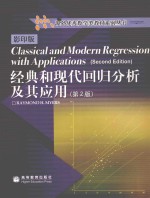图书介绍
经典和现代回归分析及其应用 第2版PDF|Epub|txt|kindle电子书版本网盘下载

- (美)麦尔斯(Myers,R.H.)著 著
- 出版社: 北京:高等教育出版社
- ISBN:7040163233
- 出版时间:2005
- 标注页数:489页
- 文件大小:69MB
- 文件页数:501页
- 主题词:
PDF下载
下载说明
经典和现代回归分析及其应用 第2版PDF格式电子书版下载
下载的文件为RAR压缩包。需要使用解压软件进行解压得到PDF格式图书。建议使用BT下载工具Free Download Manager进行下载,简称FDM(免费,没有广告,支持多平台)。本站资源全部打包为BT种子。所以需要使用专业的BT下载软件进行下载。如BitComet qBittorrent uTorrent等BT下载工具。迅雷目前由于本站不是热门资源。不推荐使用!后期资源热门了。安装了迅雷也可以迅雷进行下载!
(文件页数 要大于 标注页数,上中下等多册电子书除外)
注意:本站所有压缩包均有解压码: 点击下载压缩包解压工具
图书目录
CHAPTER 1 INTRODUCTION:REGRESSION ANALYSIS1
1.1 Regression models3
1.2 Formal uses of regression analysis5
1.3 The data base6
References7
CHAPTER 2 THE SIMPLE LINEAR REGRESSION MODEL8
2.1 The model description8
2.2 Assumptions and interpretation of model parameters9
2.3 Least squares formulation12
2.4 Maximum likelihood estimation20
2.5 Partioning total variability22
2.6 Tests of hypothesis on slope and intercept26
2.7 Simple regression through the origin(Fixed intercept)33
2.8 Quality of fitted model37
2.9 Confidence intervals on mean response and prediction intervals41
2.10 Simultaneous inference in simple linear regression47
2.11 A complete annotated computer printout56
2.12 A look at residuals57
2.13 Both x and y random66
Exercises72
References80
CHAPTER 3 THE MULTIPLE LINEAR REGRESSION MODEL82
3.1 Model description and assumptions82
3.2 The general linear model and the least squares procedure85
3.3 Properties of least squares estimators under ideal conditions91
3.4 Hypothesis testing in multiple linear regression95
3.5 Confidence intervals and prediction intervals in multiple regressions112
3.6 Data with repeated observations116
3.7 Simultaneous inference in multiple regression120
3.8 Multicollinearity in multiple regression data123
3.9 Quality fit,quality prediction,and the HAT matrix133
3.10 Categorical or indicator variables(Regression models and ANOVA models)135
Exercises153
References163
CHAPTER 4 CRITERIA FOR CHOICE OF BEST MODEL164
4.1 Standard criteria for comparing models165
4.2 Cross validation for model selection and determination of model performance167
4.3 Conceptual predictive criteria(The Cp=statistic)178
4.4 Sequential variable selection procedures185
4.5 Further comments and all possible regressions193
Exercises199
References206
CHAPTER 5 ANALYSIS OF RESIDUALS209
5.1 Information retrieved from residuals210
5.2 Plotting of residuals211
5.3 Studentized residuals217
5.4 Relation to standardized PRESS residuals220
5.5 Detection of outliers221
5.6 Diagnostic plots231
5.7 Normal residual plots242
5.8 Further comments on analysis of residuals244
Exercises244
References248
CHAPTER 6 INFLUENCE DIAGNOSTICS249
6.1 Sources of influence250
6.2 Diagnostics:Residuals and the HAT matrix251
6.3 Diagnostics that determine extent of influence257
6.4 Influence on performance267
6.5 What do we do with high influence points?270
Exercises272
References273
CHAPTER 7 NONSTANDARD CONDITIONS,VIOLATIONS OF ASSUMPTIONS,AND TRANSFORMATIONS275
7.1 Heterogeneous variance:Weighted least squares277
7.2 Problem with correlated errors(Autocorrelation)287
7.3 Transformations to improve fit and prediction293
7.4 Regression with a binary response315
7.5 Further developments in models with a discrete response(Poisson regression)332
7.6 Generalized linear models339
7.7 Failure of normality assumption:Presence of outliers348
7.8 Measurement errors in the regressor variables357
Exercises358
References365
CHAPTER 8 DETECTING AND COMBATING MULTICOLLINEARITY368
8.1 Multicollinearitv diagnostics369
8.2 Variance proportions371
8.3 Further topics concerning multicollinearity379
8.4 Alternatives to least squares in cases of multicollinea ritv389
Exercises419
References422
CHAPTER 9 NONLINEAR REGRESSION424
9.1 Nonlinear least squares425
9.2 Properties of the least squares estimators425
9.3 The Gauss-Newton procedure for finding estimates426
9.4 Other modifications of the Gauss-Newton procedure433
9.5 Some special classes of nonlinear models436
9.6 Further considerations in nonlinear regression440
9.7 Why not transform data to 1inearize?444
Exercises445
References449
APPENDIX A SOME SPECIAL CONCEPTS IN MATRIXALGEBRA452
A.1 Solutions to simultaneous linear equations452
A.2 Quadratic form454
A.3 Eigenvalues and eigenvectors456
A.4 The inverses of a partitioned matrix458
A.5 Sherman-Morrison-Woodbury theorem459
References460
APPENDIX B SOME SPECIAL MANIPULATIONS461
B.1 Unbiasedness of the residual mean square461
B.2 Expected value of residual sum of squares and mean square for an underspecified model462
B.3 The maximum likelihood estimator464
B.4 Development of the PRESS statistic465
B.5 Computation of s-i467
B.6 Dominance of a residual by the corresponding model error468
B.7 Computation of influence diagnostics468
B.8 Maximum likelihood estimator in the nonlinear model470
B.9 Taylor series470
B.10 Development of the C?-statistic471
References473
APPENDIX C STATISTICAL TABLES474
INDEX486